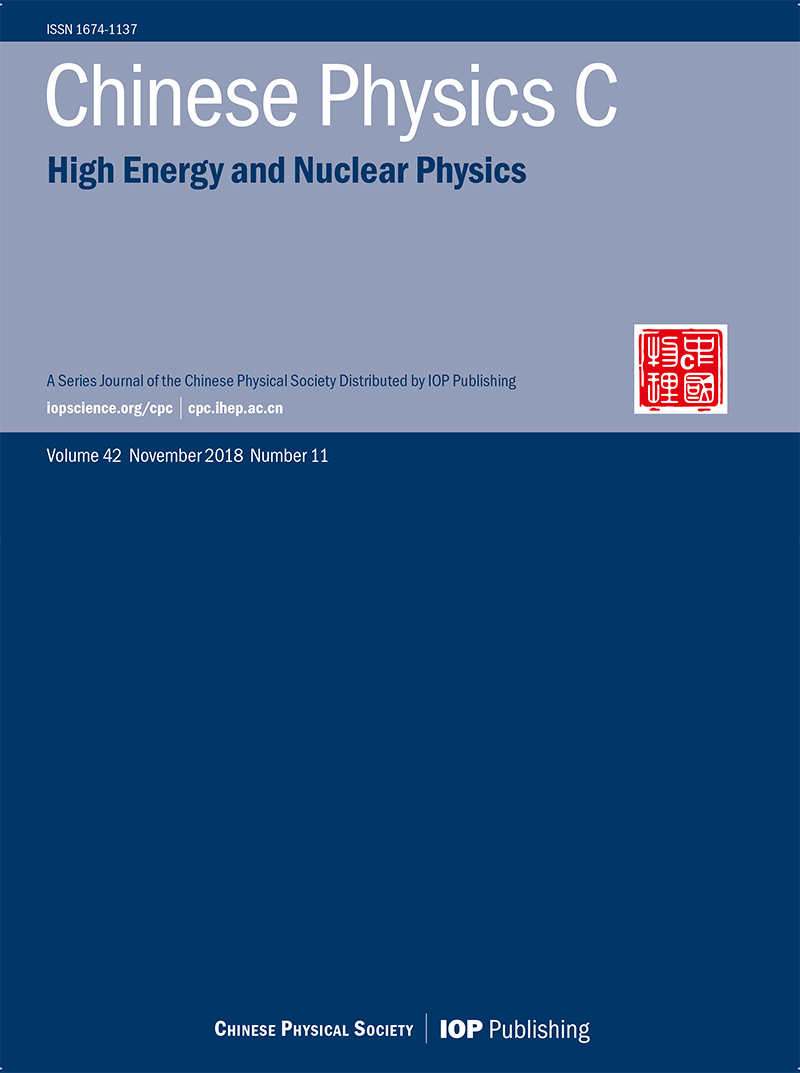2021 Vol. 45, No. 3
Display Method: |
2021, 45(3): 030001. doi: 10.1088/1674-1137/abddae
Abstract:
The NUBASE2020 evaluation contains the recommended values of the main nuclear physics properties for all nuclei in their ground and excited, isomeric (T1/2 \begin{document}$\ge$\end{document} ![]()
![]()
100 ns) states. It encompasses all experimental data published in primary (journal articles) and secondary (mainly laboratory reports and conference proceedings) references, together with the corresponding bibliographical information. In cases where no experimental data were available for a particular nuclide, trends in the behavior of specific properties in neighboring nuclei were examined and estimated values are proposed. Evaluation procedures and policies that were used during the development of this evaluated nuclear data library are presented, together with a detailed table of recommended values and their uncertainties.
The NUBASE2020 evaluation contains the recommended values of the main nuclear physics properties for all nuclei in their ground and excited, isomeric (T1/2
2021, 45(3): 030002. doi: 10.1088/1674-1137/abddb0
Abstract:
This is the first of two articles (Part I and Part II) that presents the results of the new atomic mass evaluation, AME2020. It includes complete information on the experimental input data that were used to derive the tables of recommended values which are given in Part II. This article describes the evaluation philosophy and procedures that were implemented in the selection of specific nuclear reaction, decay and mass-spectrometric data which were used in a least-squares fit adjustment in order to determine the recommended mass values and their uncertainties. All input data, including both the accepted and rejected ones, are tabulated and compared with the adjusted values obtained from the least-squares fit analysis. Differences with the previous AME2016 evaluation are discussed and specific examples are presented for several nuclides that may be of interest to AME users.
This is the first of two articles (Part I and Part II) that presents the results of the new atomic mass evaluation, AME2020. It includes complete information on the experimental input data that were used to derive the tables of recommended values which are given in Part II. This article describes the evaluation philosophy and procedures that were implemented in the selection of specific nuclear reaction, decay and mass-spectrometric data which were used in a least-squares fit adjustment in order to determine the recommended mass values and their uncertainties. All input data, including both the accepted and rejected ones, are tabulated and compared with the adjusted values obtained from the least-squares fit analysis. Differences with the previous AME2016 evaluation are discussed and specific examples are presented for several nuclides that may be of interest to AME users.
2021, 45(3): 030003. doi: 10.1088/1674-1137/abddaf
Abstract:
This is the second part of the new evaluation of atomic masses, AME2020. Using least-squares adjustments to all evaluated and accepted experimental data, described in Part I, we derived tables with numerical values and graphs which supersede those given in AME2016. The first table presents the recommended atomic mass values and their uncertainties. It is followed by a table of the influences of data on primary nuclides, a table of various reaction and decay energies, and finally, a series of graphs of separation and decay energies. The last section of this paper provides all input data references that were used in the AME2020 and the NUBASE2020 evaluations.
This is the second part of the new evaluation of atomic masses, AME2020. Using least-squares adjustments to all evaluated and accepted experimental data, described in Part I, we derived tables with numerical values and graphs which supersede those given in AME2016. The first table presents the recommended atomic mass values and their uncertainties. It is followed by a table of the influences of data on primary nuclides, a table of various reaction and decay energies, and finally, a series of graphs of separation and decay energies. The last section of this paper provides all input data references that were used in the AME2020 and the NUBASE2020 evaluations.
ISSN 1674-1137 CN 11-5641/O4
Original research articles, Ietters and reviews Covering theory and experiments in the fieids of
- Particle physics
- Nuclear physics
- Particle and nuclear astrophysics
- Cosmology
Author benefits
- A SCOAP3 participating journal - free Open Access publication for qualifying articles
- Average 24 days to first decision
- Fast-track publication for selected articles
- Subscriptions at over 3000 institutions worldwide
- Free English editing on all accepted articles
News
- CPC Announces 2025 Outstanding Reviewers
- Chinese Physics C Outstanding Reviewer Award 2023
- Impact factor of Chinese Physics C is 3.6 in 2022
- 2022 CPC Outstanding Reviewer Awards
- The 2023 Chinese New Year-Office closure
Cover Story
- Cover Story (Issue 11, 2025) The Earth-Magnet Assists DAMPE in Studying Cosmic Anti-Electrons
- Cover Story (Issue 9, 2025): Precise measurement of Ïc0 resonance parameters and branching fractions of Ïc0,c2âÏï¼Ïï¼/ K+K-
- Cover Story (Issue 8, 2025) A Novel Perspective on Spacetime Perturbations: Bridging Riemannian and Teleparallel Frameworks
- Cover Story (Issue 7, 2025) Evidence of the negative parity linear chain states in 16C
- Cover Story (Issue 1, 2025) Comments on Prediction of Energy Resolution inthe JUNO Experiment












